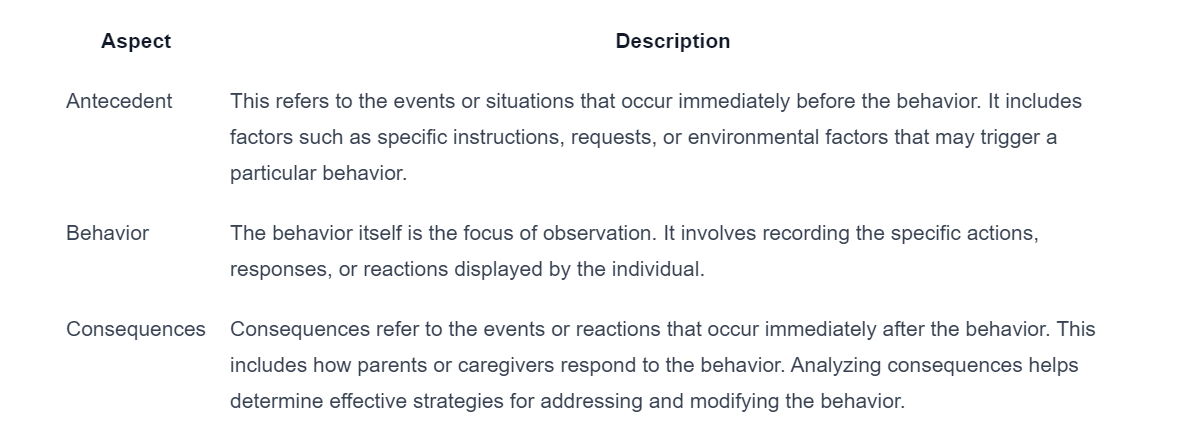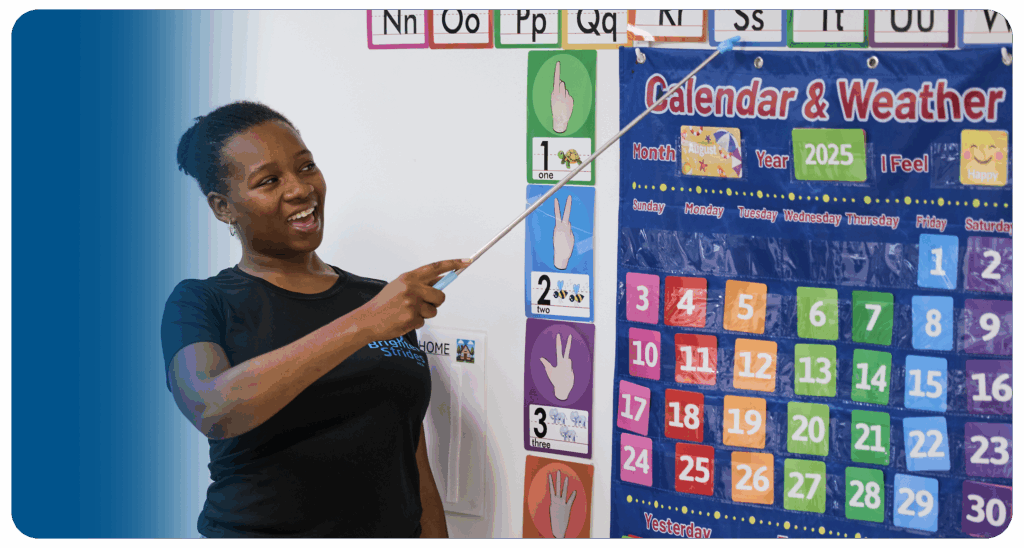Understanding Trigger Analysis in ABA
Trigger analysis, also known as antecedent analysis or functional behavior assessment, is a critical component of Applied Behavior Analysis (ABA) therapy. It involves systematically examining the antecedents, or triggers, and consequences of behavior to determine the function or purpose it serves for an individual. By identifying triggers, caregivers and ABA professionals can develop individualized behavior support plans that address the specific needs of individuals with autism.
Importance of Trigger Analysis
Trigger analysis is paramount in ABA therapy as it helps uncover the underlying causes of challenging behaviors. By understanding the triggers that precede specific behaviors, caregivers and ABA professionals can gain valuable insights into why those behaviors occur. This understanding allows for the development of targeted interventions and strategies to address and modify the behaviors effectively. Furthermore, trigger analysis empowers individuals with autism to gain self-awareness and take control over their behaviors by recognizing how their actions impact their environment.
Scope of Trigger Analysis
In ABA therapy, trigger analysis involves examining every detail that precedes an individual’s negative response to determine precisely what caused the behavior. This systematic approach allows therapists to observe and measure behaviors, record methods that link to specific levels of behavior, and identify the triggers that cause certain behaviors. By collecting and analyzing data on triggers and subsequent behaviors, therapists gain valuable insights that inform behavior support plans and guide intervention strategies [4].
Trigger analysis typically consists of two key aspects: antecedent analysis and consequence analysis. Antecedent analysis focuses on identifying the events, stimuli, or circumstances that precede and influence specific behaviors. This includes examining the environmental factors, social interactions, or internal states that may act as triggers. Consequence analysis involves analyzing the outcomes or responses that follow a behavior. Understanding the consequences helps determine whether behaviors are reinforced, maintained, or altered based on their outcomes.
By conducting comprehensive trigger analysis, ABA professionals can gain a deeper understanding of the factors that influence behavior. This knowledge allows for the development of effective behavior intervention plans that target specific triggers, modify behaviors, and promote positive outcomes for individuals receiving ABA therapy.
In the next sections, we will discuss the methods used in trigger analysis, the steps involved in the analysis process, and the key aspects of data collection and consequence analysis in ABA therapy.
Implementing Trigger Analysis
To effectively implement trigger analysis in Applied Behavior Analysis (ABA), therapists use various methods to identify triggers and develop strategies to prevent problematic behaviors. Involving caregivers in the trigger analysis process is also crucial for the success of ABA therapy.
Methods Used in Trigger Analysis
ABA therapists employ several methods to conduct trigger analysis, including:
- Direct Observation: ABA therapists directly observe the individual’s behavior in various settings and situations. This allows them to identify patterns and triggers that may contribute to the occurrence of problematic behaviors.
- Interviews with Caregivers: Caregivers play a vital role in the trigger analysis process. They provide valuable insights into behavior patterns, environmental factors, and potential triggers. ABA therapists conduct interviews with caregivers to gather information and gain a comprehensive understanding of the individual’s experiences and challenges.
- Reviewing Past Data: ABA therapists review past data, including behavior logs, incident reports, and observations, to identify recurring triggers and patterns. This retrospective analysis helps in identifying common triggers that may lead to problematic behaviors.
- Functional Behavior Assessment (FBA): A functional behavior assessment is a comprehensive approach used in ABA therapy to analyze the function or purpose of a behavior. It involves systematically gathering information about the antecedents (triggers), behaviors, and consequences to determine the underlying causes of the behavior.
Involvement of Caregivers
Involving caregivers in the trigger analysis process is crucial for the success of ABA therapy. Caregivers have unique insights into the individual’s behavior and can provide valuable information about their daily routines, interactions, and experiences. This collaboration ensures a holistic understanding of the individual’s triggers and behaviors.
By involving caregivers, ABA professionals can:
- Improve Communication: Effective communication between caregivers and ABA professionals is essential for sharing information and discussing observations, concerns, and progress.
- Gather Valuable Information: Caregivers can provide detailed information about the individual’s behavior across different settings and contexts. This information helps ABA professionals gain a comprehensive perspective and develop personalized treatment plans.
- Develop Personalized Treatment Plans: Caregivers’ involvement allows ABA professionals to consider the individual’s unique needs, preferences, and circumstances when developing intervention plans. Personalized treatment plans have a higher likelihood of success as they are tailored to the individual’s specific triggers and behaviors.
Collaboration between caregivers and ABA professionals is critical throughout the trigger analysis process. ABA professionals provide the expertise and guidance necessary to conduct assessments, analyze triggers, and develop effective intervention plans. By working together, caregivers and ABA professionals can support the individual in managing triggers, reducing problematic behaviors, and promoting positive outcomes.
Trigger analysis in ABA therapy is not only conducted by ABA therapists but can also be utilized by teachers, parents, and caregivers to identify the roots of challenging behaviors in children. This understanding leads to better support and provision of necessary resources.
Steps in Trigger Analysis
To effectively analyze triggers in Applied Behavior Analysis (ABA), several steps are involved in gathering and understanding data. These steps include data collection and observation, as well as conducting a functional behavior assessment (FBA).
Data Collection and Observation
In trigger analysis, accurate and detailed data collection is essential. ABA therapists employ various methods, such as direct observation, interviews with caregivers, reviewing past data, and functional behavior assessments (FBA), to identify triggers and develop strategies to prevent problematic behaviors.
During the data collection process, therapists closely observe and record specific details related to the problem behaviors exhibited by the individual. This includes noting noises made, facial expressions, objects thrown, and actions taken during the occurrence of these behaviors [4]. These detailed observations provide valuable information for a comprehensive trigger analysis in ABA therapy.
Functional Behavior Assessment
Functional Behavior Assessment (FBA) is a systematic process used to identify and understand the function or purpose of a behavior. By conducting an FBA, ABA professionals gain insights into the triggers that lead to challenging behaviors exhibited by individuals with autism.
An FBA involves multiple steps, including defining the target behavior, collecting data on antecedents (events or circumstances preceding the behavior) and consequences (events or circumstances following the behavior), and developing a hypothesis about the function of the behavior. This comprehensive assessment helps identify the underlying causes of the behavior and guides the development of appropriate intervention strategies.
By combining data collection and observation with the systematic approach of conducting an FBA, ABA professionals can gain a deeper understanding of the triggers that contribute to challenging behaviors. This knowledge is vital for developing effective behavior intervention plans and implementing strategies to minimize or prevent the occurrence of these behaviors.
Through the diligent application of data collection, observation, and functional behavior assessment, ABA therapists can uncover the triggers that impact individuals and work towards maximizing the effectiveness of interventions. With the insights gained from trigger analysis, tailored strategies can be implemented to support individuals in managing their behaviors and achieving their goals.
Key Aspects of Trigger Analysis
Trigger analysis is a crucial component of Applied Behavior Analysis (ABA) therapy, as it enables caregivers and ABA professionals to uncover the underlying causes of challenging behaviors. By identifying triggers, individuals with autism can receive individualized behavior support plans tailored to their specific needs. Two key aspects of trigger analysis are ABC data collection and analyzing consequences.
ABC Data Collection
The ABC model (Antecedent, Behavior, Consequences) is commonly used in ABA therapy for trigger analysis. This model involves recording events before the behavior (antecedent), observing the behavior itself, and noting the consequences that follow.
The process of collecting ABC data provides valuable insights into the patterns and triggers of specific behaviors. It helps identify the factors that precede and follow the behavior, enabling caregivers and professionals to gain a comprehensive understanding of the environment and circumstances that contribute to the behavior.

Analyzing Consequences
Analyzing the consequences of problem behaviors is a significant aspect of trigger analysis. It involves understanding how parents or caregivers respond to the behavior and documenting the immediate reactions that follow. By carefully observing and documenting these consequences, therapists can determine effective strategies for addressing and modifying the behavior.
Analyzing consequences helps identify whether certain behaviors are reinforced or discouraged by the reactions that follow. It allows caregivers and professionals to understand the impact of their responses and make necessary adjustments to promote positive behavior change. Through this process, alternative methods can be found to address challenging behaviors and redirect them towards positive reinforcement.
In conclusion, key aspects of trigger analysis in ABA therapy involve collecting ABC data to understand the antecedents, behaviors, and consequences of specific behaviors. Analyzing consequences helps caregivers and professionals identify effective strategies for addressing and modifying behaviors, ultimately promoting positive behavior change and enhancing the well-being of individuals with autism.
Identifying Triggers
In the field of Applied Behavior Analysis (ABA), trigger analysis, also known as antecedent analysis, plays a crucial role in understanding and addressing specific behaviors. Identifying triggers is the final step in trigger analysis, and it involves analyzing the notes and observations to determine the antecedents that prompt certain behaviors. This step requires patience, consistency, and experimentation with responses until the triggers are identified.
Final Step in Trigger Analysis
Once the data has been collected and analyzed, the final step in trigger analysis is to identify the specific triggers that lead to the observed behaviors. This involves carefully examining the notes, observations, and patterns to understand what the child is attempting to achieve with their behavior. By identifying the triggers, ABA therapists can develop tailored intervention strategies that focus on addressing the root causes of the behavior.
Importance of Patience and Consistency
Identifying triggers requires patience and consistency from both the ABA therapist and caregivers. It is a process of trial and error, as different behaviors may have multiple triggers. Through ongoing observation and analysis, the triggers become clearer over time. It is important to remain patient and consistent in collecting data, analyzing patterns, and experimenting with different responses until the triggers are accurately identified.
By identifying the triggers, caregivers can gain a deeper understanding of the underlying factors that contribute to specific behaviors. This understanding enables them to respond appropriately and develop strategies that do not reinforce problem behaviors. Patience and consistency are key in this process, as it may take time to pinpoint the triggers accurately.
In conclusion, identifying triggers is the final step in trigger analysis in ABA. It involves analyzing the notes and observations, understanding what the child wants to achieve with their behavior, and determining the factors that prompt specific behaviors. Patience and consistency are vital throughout this process, allowing caregivers and ABA therapists to develop effective intervention strategies tailored to the individual’s needs.
Application and Benefits
Trigger analysis, though commonly associated with Applied Behavior Analysis (ABA) therapy, extends beyond this field and offers valuable insights and benefits in various contexts. By identifying triggers and understanding their impact on behavior, individuals can enhance their social skills and self-awareness.
Trigger Analysis Beyond ABA
Trigger analysis is not limited to ABA therapists. Teachers, parents, and caregivers also utilize this approach to identify the root causes of challenging behaviors in children, leading to a better understanding of their needs and the provision of necessary support and resources. In schools, teachers and education staff can employ trigger analysis methods to assist students in overcoming challenges such as testing anxiety, stage fright, depression, and conflicts in the classroom. This approach helps predict behavior outcomes and enables the development of personalized behavior management programs for a positive learning experience.
Enhancing Social Skills and Self-Awareness
Within the realm of ABA therapy, trigger analysis plays a vital role in helping individuals, particularly those with autism, understand how their actions impact their environment. By pinpointing behaviors and emotions before, during, and after an event, individuals gain insight into the relationship between their actions and the consequences that follow [3]. This heightened awareness promotes the development of social skills and self-regulation, enabling individuals to navigate social interactions more effectively.
By identifying triggers, whether they be sensory, environmental, or emotional, individuals can learn to anticipate and manage their responses. This understanding empowers individuals to make more informed choices and implement strategies to mitigate or redirect challenging behaviors.
Trigger analysis also provides caregivers and ABA professionals with valuable information related to triggers and subsequent behaviors. Armed with this knowledge, they can develop individualized behavior support plans that address the specific needs of individuals with autism. These plans may include proactive strategies, such as implementing visual supports or teaching coping skills, to help individuals navigate triggering situations more successfully [2].
In summary, trigger analysis extends beyond the scope of ABA therapy. Its application in various contexts empowers individuals to enhance their social skills, self-awareness, and overall well-being. By identifying triggers and understanding their impact on behavior, individuals can develop strategies to navigate challenging situations more effectively and improve their quality of life.
References
- https://www.abtaba.com/blog/trigger-analysis-in-aba
- https://www.goldstarrehab.com/parent-resources/trigger-analysis-in-aba
- https://www.crossrivertherapy.com/aba-therapists/trigger-analysis
- https://elemy.wpengine.com/aba-terms/trigger-analysis
- https://www.adinaaba.com/post/trigger-analysis-in-aba
- https://www.discoveryaba.com/aba-therapy/trigger-analysis-in-aba
- https://www.autismparentingmagazine.com/trigger-analysis-aba/





